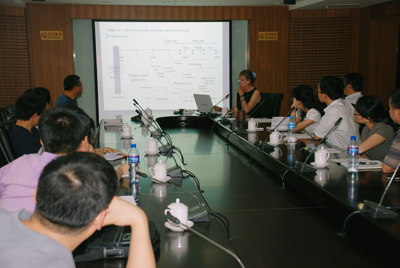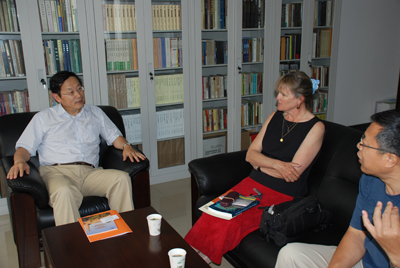Associate Professor Alison Betts of the Archaeological Department of Australia’s Sidney University Gives a Lecture at IA CASS
From:Chinese Archaeology NetWriter:Date:2009-07-09
From two to four p.m. on July 1st, 2009, Professor Alison Betts of the Archaeological Department of Australia’s Sidney University gave a lecture: Communications between Eastern and Western Culture—Central Asian Archaeological Studies. Director Wang Wei presided the meeting, Professor Jia Weiming translated, and the staff members and graduate students attended the lecture.

Professor Betts first briefly spoke of the ten years she spent working in Mongolia and Central Asia, and introduced two of her important projects: “Archaeological Cultures on the Eurasian Continent during the Bronze Age” and “Urban Sites and Religion in Hualazimo (Khwarezm).”[1] Professor Betts next concisely outlined the developments of ancient cultures in Central Asia between the Neolithic and Bronze Ages.
In approximately 4,000 B.C., the New Neolithic Age culture that originated at the foot of Kopet Dagh Mountain had already begun to cultivate several varieties of plants and to raise sheep, goats, and other animals. Around 3,000 B.C., the Central Asian cultures entered the Bronze Age and became separated into two culturally distinct Northern and Southern civilizations. The Northern peoples developed into a typical grasslands culture. Taking the Qiemu erqieke ruins and the Okunev burial site as representatives, Professor Betts conducted a penetrative comparative analysis of the Bronze Age cultures in the Northern region and the peripheral tribes, relying on geographical position and pottery shards. In contrast, the Southern peoples developed into an oasis culture. From the early to late periods of the Bronze Age, as each tribe gradually migrated from the mountains to the oases, they discovered irrigation agriculture and entered a flourishing period. Professor Betts also discussed the spread of Bactrian culture in India and Iranian and posed questions regarding the slight influences these cultures had on the region of Xinjiang in China (only typical spouted vessels have been discovered).
Later Professor Betts explained the research and important archaeological discoveries that have been made in the Hualazimo region, such as square citysites and temple buildings. Professor Betts gave a detailed introduction and analysis of the temples’ age (according to carbon14-dating data, the temples were constructed between the 2nd century B.C. and the 2nd century A.D.), structure (including Zoroastrian altars and sacrificial areas), distinctive features, function, murals and other remains.

Based on research into the ancient cultures of Central Asia, Professor Betts proceeded to study the origins and development of Zoroastrianism, as well as the cultural interchanges between Central Asia, China and Mongolia during the same period; in addition, relying on new discoveries and research in the field of archaeology, she introduced thought-provoking new knowledge that challenged the existing boundaries of the field. Discussing everything from the dimensions of an artifact, to the relationship between king-power and ritual-power, the participants in the conference carried on an animated debate with Professor Betts. (Translated by Carissa Fletcher)
[1] Khwarezm was an ancient historic kingdom. Its territories now form part of modern Turkmenistan and Uzbekistan.

